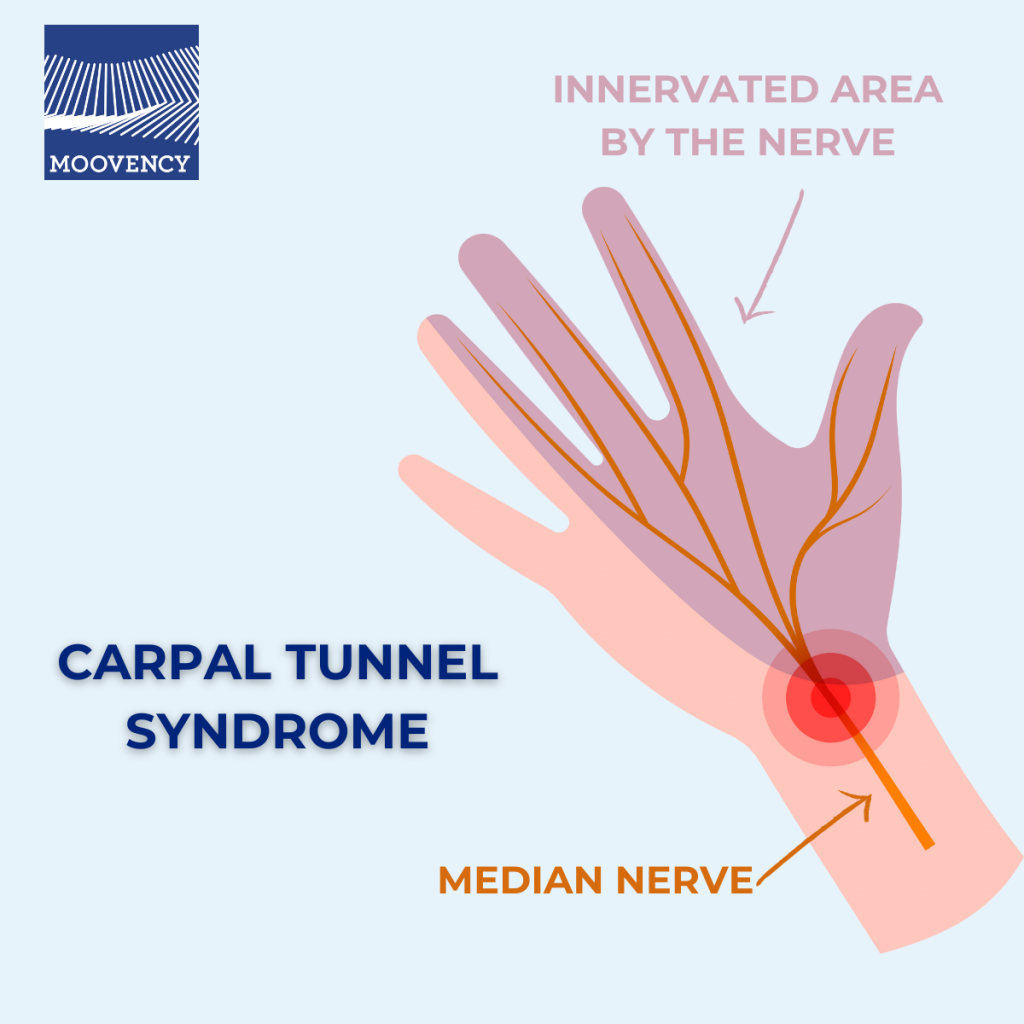Focus on a MSD : Carpal Tunnel Syndrome
Last time, we discussed the most common work-related musculoskeletal disorders (MSD); today, we’ll focus on one of the conditions affecting the hand and wrist : carpal tunnel syndrome.
Let’s explore this musculoskeletal disorder together, including its causes, symptom progression, possible treatments, and most importantly, how to prevent it !
Carpal tunnel : Definition

The carpal tunnel is a small passageway located at the center of the wrist on the anterior side. This carpal tunnel allows the passage of the median nerve and contains the tendons of the flexor muscles.
The median nerve is a sensory and motor nerve responsible for providing sensation and movement to the hand, particularly to four fingers: the thumb, index, middle, and part of the ring finger.
What is carpal tunnel syndrome?
Carpal tunnel syndrome occurs when the median nerve is compressed, often due to inflammation of a ligament or the wrist tendons. This puts pressure on the nerve, causing it to become trapped.
This syndrome can be characterized by various symptoms, such as :
- A decrease in strength/weakness in the hand and wrist.
- Tingling or recurrent numbness;
- Decreased sensitivity in the hand;
- Various pains that can radiate into the forearm, affecting the first three fingers of the hand (thumb, index, and middle).
These symptoms can occur during movement or at rest, and the pain may intensify at night.
Carpal Tunnel Syndrome : Causes
In the professional environment, numerous risk factors contribute to the compression of the median nerve. The risk is high for employees performing repetitive movements in awkward postures. Examples of such movements include:
- Wrist twisting movements.
- Tasks requiring significant hand force.
- Tasks requiring force from the thumb and index finger (e.g., tool handling);
- Static force (hand and wrist fixation) on a specific task;
- Working conditions in a cold environment and/or with vibrations.
Other factors that may contribute to the development of carpal tunnel syndrome include hormonal factors (pregnancy, menopause, hypothyroidism) or metabolic factors (diabetes), previous injuries (fractures), and sometimes, the syndrome may occur without any identified cause.
Carpal Tunnel Syndrome : Treatments
Depending on the severity of the symptoms, various treatments can be considered to prevent irreversible consequences.
For milder cases, temporary cessation of the responsible movements and rest may be sufficient to alleviate symptoms. A conservative medical treatment can also be implemented, including:
- Wearing a wrist immobilization splint: to relieve symptoms, typically worn at night for a period of 3 months.
- Taking analgesics or anti-inflammatories: as prescribed by a doctor.
In cases where medical treatment fails, or if the symptoms are already severe and significant, surgical treatment may be considered.
According to Ameli.fr, each year in France, a little over 130,000 people undergo surgery for this syndrome.*
Carpal Tunnel Syndrome: Recognition as an Occupational Disease
Carpal Tunnel Syndrome is recognized as a musculoskeletal disorder and is the most expemost experiencedmployees in a work environment. Wrist-finger-hand injuries account for 39% of cases of musculoskeletal disorders. Several professions are affected :
- Retail.
- Healthcare and social services.
- Construction.
- Food industry.
- Cleaning services;
- Automotive manufacturing;
- Hospitality and catering.
To prevent the pain associated with this MSD, it is essential to pay attention to the wrist joint. Rest during repetitive movements, workplace adjustments, task diversification, stretching exercises…
Furthermore, conducting an ergonomic analysis of the workplace and raising awareness among employees about MSDcan be essential levers for effectively preventing carpal tunnel syndrome.
At Moovency, we support companies in preventing MSD with our KIMEA solutions and the expertise of our ergonomists. Our capture tools include our connected gloves: these provide increased precision in analysis and allow for automatic measurement of your operators’ wrist movements, thanks to sensors integrated into our gloves! This enables better prevention of carpal tunnel syndrome and ensures the well-being of your employees.
Source : Ameli.fr & Olimag
